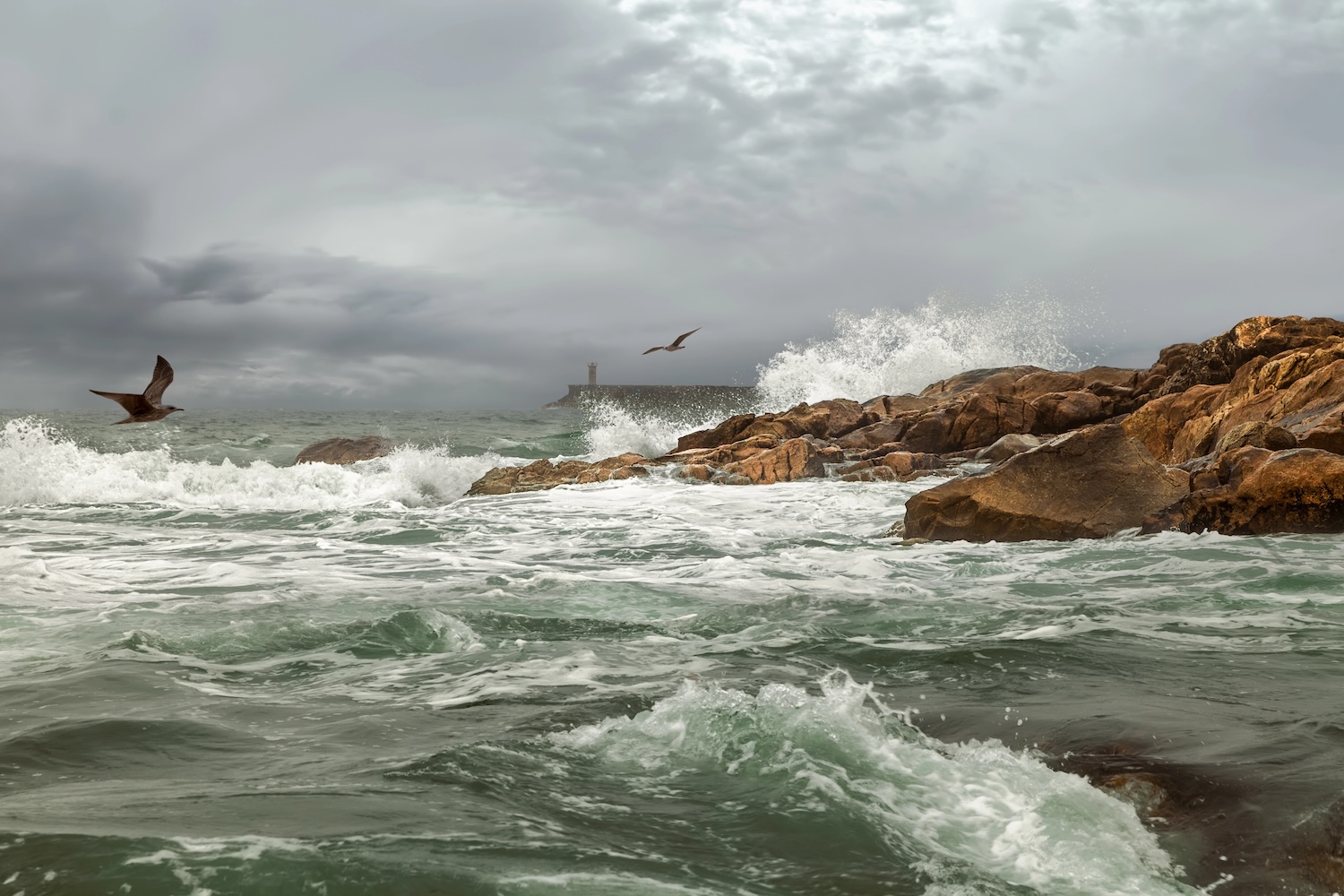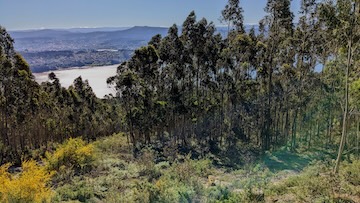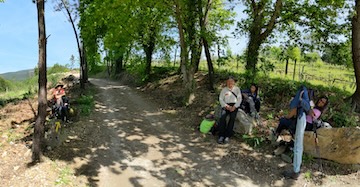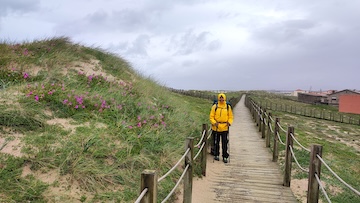A Seasonal Guide to the Camino Portuguese Coastal Way
The Coastal Way of the Camino Portuguese is a heavily influenced by the Atlantic Ocean, that’s what we discovered in an our walk, was that we needed a Seasonal Guide to the Camino Portuguese Coastal Way. The Atlantic moderates the temperatures along the coast, providing a cooler and more temperate walking environment compared to the inland routes. It can also result in blustery winds and unexpected showers. Understanding these climate variations is crucial for pilgrims to prepare adequately and enjoy their journey, for example, what gear to carry? Of late, there have been changes in the climate patterns, that we experienced in our recent camino.
Spring along the Coastal Way, from March to May, brings a gradual warming trend with daytime temperatures typically ranging between 12°C and 18°C. However, we saw daytime temperatures soar to 25 C, with lots of sunshine. Just a week before there had been continuous torrential rain unlike the expected occasional rain showers. In spring the rain is meant to be brief and interspersed with periods of sunshine, allowing the coastal route to turn a lush green dotted with wild flowers.
Summer, from June to August, offers favorable weather conditions for the Coastal Way. With average temperatures hovering between 18°C and 25°C, the warm but not overly hot climate is ideal for long days of walking, provided you wear a hat, suitable clothes and drink a lot of water. The refreshing sea breezes mitigate the summer heat, making the coastal path much more comfortable compared to the stifling heat that can sometimes characterise the inland routes.
As autumn approaches, from September to November, pilgrims experience a gentle cool down with temperatures that make for pleasant walking conditions. The coastal air, mixed with the crispness of autumn, brings a different kind of beauty to the route. The sea remains a constant presence, and the changing colors of the foliage add to the beauty of the landscape. Rainfall during this season is generally less frequent than in spring, allowing for clearer skies and more predictable walking days.
Winter along the coast, from December to February, is milder than in the inland areas. While the temperatures are cooler, frost is rare, and the weather remains moderate compared to the freezing conditions that can occur further inland. However, winter also brings its challenges, including increased rainfall and stronger winds, which can make some coastal paths less accessible and more challenging to navigate. At these times, it may be better to use the original coastal route rather than the Littoral route by the shore.
For pilgrims planning their journey on the Camino Portuguese Coastal Way, understanding these seasonal weather patterns is essential. Each season offers its own unique set of conditions, influencing not only the physical preparation required but also the type of experience you can expect. Whether seeking the lush landscapes of spring, the warm summer breezes, the serene beauty of autumn, or the quiet solitude of winter, knowing what each season holds helps ensure a more enjoyable and fulfilling pilgrimage.
Choose the Season for Your Pilgrimage
Choosing the optimal season for walking the Coastal Way of the Camino Portuguese hinges on individual preferences and what each pilgrim hopes to gain from their journey. Each season offers distinct advantages that can cater to varying interests, whether it’s ideal walking conditions, opportunities for social interactions, or the desire for solitude.
For those seeking the warm dry weather, the summer months from June to August are ideal. During this period, the climate is warm and generally dry, providing excellent conditions for enjoying the coastal landscapes and the many beautiful beaches along the route. The sea breeze offers a respite from the heat and the churning waves and occasional sea spray gives a maritime flavour to camino. Summer is also perfect for those who enjoy swimming, as the ocean temperatures are inviting for a refreshing dip after a day’s walk.
However, if your priority is to avoid crowds and seek a more introspective journey, late autumn through early winter might be the better choice. From late October to early February, the Coastal Way quietens down, with fewer pilgrims treading the path. The cooler temperatures and occasional misty days add a mystical element to the landscape, offering a different perspective of the coast’s natural beauty.
For those interested in cultural experiences, aligning the pilgrimage with local festivals can greatly enrich the journey. Summer and early autumn are particularly busy times along the Coastal Way, as local towns host various festivals and events celebrating maritime culture, local cuisine, and traditional music. These events provide a fantastic opportunity to engage with local communities, experience Portuguese hospitality, and enjoy the festive atmosphere that characterizes the region during these months.
Ultimately, the choice of when to walk the Coastal Way should align with what a pilgrim values most in their journey. Whether it’s the lively interactions of the summer months, the tranquil solitude of winter, or the cultural richness of festival season, each time of year offers something unique. By considering these factors, pilgrims can select a season that not only meets their practical needs but also makes the Camino Portuguese Coastal Way as rewarding a pilgrimage as possible.
Challenges of Coastal Weather
While the Coastal Way of the Camino Portuguese offers stunning views and unique experiences, it also presents specific weather-related challenges that can impact your journey. Understanding these challenges is essential for proper preparation and ensuring a safe and enjoyable pilgrimage.
The biggest and most blustery challenge along the Coastal Way is strong winds that can buffet a walker out in the open. Particularly in the winter and spring months, the winds can be intense, sometimes making walking difficult and tiring. These strong gusts are not only physically challenging but can also lead to quicker fatigue, which is something pilgrims should be prepared for by planning shorter walking days or choosing more sheltered routes when necessary.
Fog and humidity are other significant factors along the coast, especially prevalent in the early mornings and late evenings of spring and summer. The fog can reduce visibility drastically, which not only makes navigation harder but also adds a layer of moisture that can make paths slippery. This requires pilgrims to be cautious and possibly adjust their walking schedule to midday when the fog typically lifts and visibility improves.
Additionally, sun exposure along the Coastal Way can be intense, particularly during the summer months. The combination of direct sunlight and the reflective properties of the sea can increase the risk of sunburn and heat-related illnesses. It’s crucial for pilgrims to protect themselves by wearing high SPF sunscreen, a wide-brimmed hat, and light, long-sleeved clothing to shield the skin. Staying hydrated is also vital to prevent heat exhaustion, so be sure to carry sufficient water and plan stops to replenish fluids regularly. Fortunately, there are many drinking fountains along the way, and water is safe to drink.
Preparing for these coastal weather challenges involves not only packing the right gear but also planning the pilgrimage with an awareness of how the weather can change throughout the day. By doing so, pilgrims you can ensure a more comfortable and safe journey along the beautiful Coastal Way of the Camino Portuguese.
Preparing for the Coastal Way
Prepare adequately for the Coastal Way of the Camino Portuguese to ensure a successful and enjoyable pilgrimage. This involves planning around gear, timing, and accommodations.
Firstly, the right gear is crucial. Given the coastal path’s exposure to wind and sea spray, a windproof and waterproof jacket is indispensable. Layering is also key, as conditions can change rapidly from cool breezes to warm sunlight within a few hours. Durable, moisture-wicking clothing will provide comfort and prevent chafing during long walks. Additionally, a good quality hat and sunglasses are necessary to protect against the sun, alongside sunscreen to prevent burns on sunny days.
Starting early in the day helps you avoid the midday sun, particularly in the summer months when temperatures can climb considerably. This strategy not only helps in managing exposure to heat but also takes advantage of the generally clearer, calmer weather in the mornings before any wind picks up. Moreover, early starts mean you can enjoy the quiet of the morning hours, often a magical time on the Coastal Way as the sun rises over the Atlantic.
Accommodations along the Coastal Way can vary greatly, from albergues, rustic hostels to comfortable guesthouses and hotels. During peak season in the summer months, these can fill up quickly, so booking in advance is advisable. This not only secures a place to stay but also allows you to plan your daily walking distances more accurately. In the quieter seasons, you may have more flexibility with where you stay, but it’s still wise to have a plan and a few backups in case some places are closed, especially in the late autumn and winter.
By carefully considering these aspects of your pilgrimage — gear, timing, and accommodations — you are more likely to enjoy a comfortable and fulfilling experience on the Coastal Way. This preparation allows you to focus more on the journey itself, absorbing the stunning landscapes and rich cultural encounters that the Camino Portuguese offers. But its wise to remember that not everything goes as planned. That’s where the adventure comes in. Don’t be afraid, plan as well as you can and go!
Buen Camino!
Be the first to read the book!
Join the launch team of the upcoming book. I would love to share the early drafts, bonuses and general experience of writing the book about our camino. For an author the journey is not over until the book is written.




